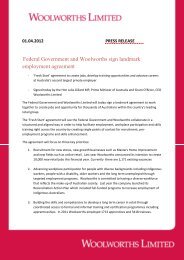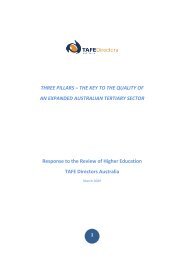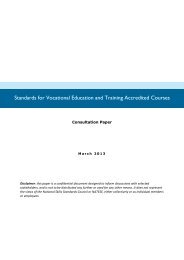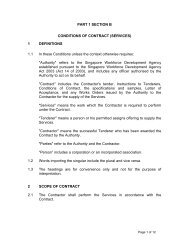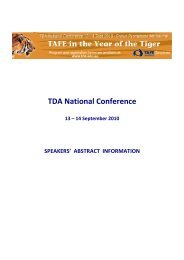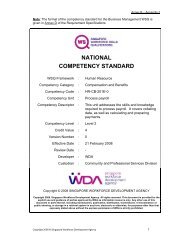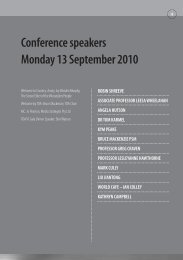TDA policy position papers on tertiary education - TAFE Directors ...
TDA policy position papers on tertiary education - TAFE Directors ...
TDA policy position papers on tertiary education - TAFE Directors ...
Create successful ePaper yourself
Turn your PDF publications into a flip-book with our unique Google optimized e-Paper software.
TEQSA – Nati<strong>on</strong>al VET Regulator AlignmentThe evoluti<strong>on</strong> of a nati<strong>on</strong>al <strong>tertiary</strong> regulator and a separate VETregulator has arisen primarily as a result of recommendati<strong>on</strong>sc<strong>on</strong>tained in the Bradley Review. The Review recommended thatnati<strong>on</strong>al regulati<strong>on</strong> was appropriate for an expanded <strong>tertiary</strong> sector andthat the interim <str<strong>on</strong>g>positi<strong>on</strong></str<strong>on</strong>g> of two regulators should transiti<strong>on</strong> into <strong>on</strong>eregulator by 2012.There are many legal and c<strong>on</strong>stituti<strong>on</strong>al impediments to achieving atimely transiti<strong>on</strong> but just as importantly as these, <str<strong>on</strong>g>TDA</str<strong>on</strong>g> c<strong>on</strong>siders thatthe existing provider categories in the Nati<strong>on</strong>al Protocols for HigherEducati<strong>on</strong> do not accommodate the variety of instituti<strong>on</strong>al types thatexist now in that sector. Moreover, in the VET sector, there is nodifferentiati<strong>on</strong> between 5,000+ existing providers. <str<strong>on</strong>g>TDA</str<strong>on</strong>g> maintains thatclarifying the provider categories in Higher Educati<strong>on</strong> and establishingprovider categories in the VET sector are essential steps to enable thetransiti<strong>on</strong> to occur. Without these steps being taken, there would beno comm<strong>on</strong>ality of approach to this issue.The Australian Qualificati<strong>on</strong>s FrameworkThe advent of a single qualificati<strong>on</strong>s architecture in the revisedAustralian Qualificati<strong>on</strong>s Framework (AQF) is further impetus for the<strong>tertiary</strong> sector. According to the Communiqué for a recent MinisterialCouncil for Tertiary Educati<strong>on</strong> and Employment (MCTEE) Meeting,the AQF will ‘result in an increasingly integrated <strong>tertiary</strong> sector, withstr<strong>on</strong>ger pathways between VET and Higher Educati<strong>on</strong>’. 8 The TEQSAlegislati<strong>on</strong> has already incorporated the revised AQF as a vehicleto clarify the definiti<strong>on</strong> of Higher Educati<strong>on</strong> courses. As it becomesmore widely known across all educati<strong>on</strong> sectors, the revised AQF willprovide a clear and c<strong>on</strong>sistent basis that providers can use to publicisethe level of qualificati<strong>on</strong>s offered.8Communiqué for the MCTEE Meeting, 19 November 2010, p. 2.4 THE CASE TO REVIEW PROVIDER CATEGORIES IN HIGHER EDUCATION
PROVIDER CATEGORIES IN HIGHEREDUCATIONProvider Categories Proposed under TEQSAAccording to the April 2011 c<strong>on</strong>sultati<strong>on</strong> draft of the TEQSA ProviderCategories, the former Nati<strong>on</strong>al Protocols will be replaced by thefollowing six Provider Categories:> > Australian University> > Australian University College> > Australian University of Specialisati<strong>on</strong>> > Higher Educati<strong>on</strong> Provider> > Overseas University> > Overseas University of Specialisati<strong>on</strong>.These latest categories still reflect the former Nati<strong>on</strong>al Protocols,however, the last category is new.Overview of Higher Educati<strong>on</strong> ProvidersThe range of HEPs has gradually evolved over time in line withperceived demand and commercial potential and with little by way of aplanned approach. The variati<strong>on</strong> is wider than the provider categoriesabove would imply. HEPs can now be loosely grouped in terms of:University or n<strong>on</strong>-UniversityBroad-based, General or SpecialistResearch intensive or not research intensivePublic or PrivateAustralian or Internati<strong>on</strong>al/OverseasRegistered Training Organisati<strong>on</strong>(RTO) in the VET sectorornot an RTOBox 1 provides an indicative overview of how these groupingscurrently apply.<strong>TAFE</strong> DIRECTORS AUSTRALIA5
Box 1: An Overview of Australian Higher Educati<strong>on</strong> Providers(HEPs)BROAD-BASED/GENERALUNIVERSITYQUADRANT 1:UNIVERSITY/BROAD-BASED33% of all HEPs39 Australian universities(inc. 14 RTOs)> 37 public> 2 private3 other approved uses of‘University’> Open UniversitiesAustralia> Carnegie Mell<strong>on</strong>University> University CollegeL<strong>on</strong>d<strong>on</strong>0 designated ‘AustralianUniversity College’OTHER (NON-UNIVERSITY) HEPQUADRANT 2:OTHER HEP/BROAD-BASED12% of all HEPs17 HEP providers (inc. 14 RTOs)> 9 <strong>TAFE</strong> institutes + <strong>TAFE</strong>NSW> 2 large private providers> 4 attached to universitiese.g. M<strong>on</strong>ash College,Deakin Prime> 1 indigenousSPECIALISTQUADRANT 3:UNIVERSITY/SPECIALIST0% of all HEPs0 designated ‘AustralianUniversity of Specialisati<strong>on</strong>’0 designated ‘OverseasUniversity of Specialisati<strong>on</strong>’The 39 universities in Quadrant 1have 95% of all HE provisi<strong>on</strong>QUADRANT 4:OTHER HEP/SPECIALIST55% of all HEPs70 HEP providers (inc. 33 RTOs)> 67 private> 2 public (AFTRS, NIDA)> 1 <strong>TAFE</strong>Specialising in:> Theology – 17> Business/IT – 16> Creative Industries – 15> Health – 12> Hospitality – 6> Other – 4Quadrants 2 and 4 share 5% of allHE provisi<strong>on</strong>Sources:www.goingtouni.gov.au – DEEWR website ‘Going to Uni’ – Higher Educati<strong>on</strong>for Students in Australia – All Australian Providers.www.ntis.gov.au/ – Nati<strong>on</strong>al Training Informati<strong>on</strong> Service (NTIS) – All RTOs.Note that listings are not c<strong>on</strong>sistently compiled and may be understated,particularly in Quadrant 4. For example, some universities have separateregistrati<strong>on</strong> for their associated (predominantly internati<strong>on</strong>al) colleges (as inQuadrant 2), while others do not.6 THE CASE TO REVIEW PROVIDER CATEGORIES IN HIGHER EDUCATION
CommentaryExamining Box 1, a number of observati<strong>on</strong>s can be made:> > The two most populated quadrants are 1 and 4, quadrant 1because of its dominance in provisi<strong>on</strong> (95% of student load) andquadrant 4 because of its dominance in provider numbers (55%of all HEPs).> > There are three examples of instituti<strong>on</strong>s other than the 39universities using the name ‘university’, <strong>on</strong>e of which is ac<strong>on</strong>sortium of Australian universities and the other two areoverseas universities operating in Australia.> > There are no examples of ‘Australian University College’,‘Australian University of Specialisati<strong>on</strong>’ or the proposed newcategory of ‘Overseas University of Specialisati<strong>on</strong>’.> > In all, five categories using the title ‘university’ are now proposedfor 42 HEPs, with <strong>on</strong>ly two of these categories populated inpractice, while the remaining 86+ HEPs are relegated to then<strong>on</strong>descript category of ‘Higher Educati<strong>on</strong> Provider’.> > Fourteen of the 39 universities are also RTOs in the VET sector –three times more than would be accounted for by the dual sectoruniversities. In total, 48% of all HEPs are also RTOs.> > Apart from the universities and their associated (oftenpredominantly internati<strong>on</strong>al) colleges, there are relatively fewbroad-based HEPs, with most of these being drawn from the 59<strong>TAFE</strong> institutes.> > The 70 n<strong>on</strong>-university specialist HEPs (quadrant 4) are, relativelyspeaking, small, with 47% also being RTOs. Sixty-six of the 70are accounted for by five specialist areas, the dominant <strong>on</strong>e ofwhich is Theology/Faith-based.> > With the overwhelming prep<strong>on</strong>derance of providers in quadrant 4being in the private sector, there are no n<strong>on</strong>-university specialistHEPs operating in the skill shortage areas such as building andc<strong>on</strong>structi<strong>on</strong>, electrical/electr<strong>on</strong>ics or engineering/manufacturing.<str<strong>on</strong>g>TDA</str<strong>on</strong>g> members have extensive VET expertise in these as well asother areas.The proposed six categories of HEPs are unduly weightedtowards universities, maintaining or creating categories forinstituti<strong>on</strong>s that do not even exist yet.No attenti<strong>on</strong> has been paid to clarifying the distincti<strong>on</strong>sbetween the remaining HEPs, for which there is still <strong>on</strong>ly<strong>on</strong>e category. This ignores the fact that this category has thepotential to generate diversity and to c<strong>on</strong>tribute to nati<strong>on</strong>alproductivity by addressing skill shortages.<strong>TAFE</strong> DIRECTORS AUSTRALIA7
study offered, not the level of qualificati<strong>on</strong>s or any other features.All categories involve offering Masters (Research) and Doctoraldegrees. This does not foreshadow a more diverse sector.> > The intent of the new Criteri<strong>on</strong> 2 appears to be to create furtherbarriers to entry into the Australian university category and tocurb further diversity of organisati<strong>on</strong>al type by imposing a timeframeand quantum for self-accreditati<strong>on</strong>, effectively preventingany further universities being established domestically for theforeseeable future. 9> > The potential for the ‘Australian University College’ category tobe used as a transiti<strong>on</strong> category to full university status has beenre-introduced 10 (in Criteri<strong>on</strong> 2) but since this potential has existedand was not used in the past, the title may well c<strong>on</strong>tinue toremain superfluous or redundant.> > The research requirement in all three categories is problematicfrom a number of points of view:> The recent report <strong>on</strong> Excellence in Research for Australia 11shows that the current research output varies widely acrossthe university sector with some universities having <strong>on</strong>lysmall pockets of research excellence.> It unnecessarily reinforces exclusivity in an increasinglydiverse <strong>tertiary</strong> educati<strong>on</strong> market.> It is not c<strong>on</strong>sistent with internati<strong>on</strong>al practice.> It leads to already scarce research dollars being potentiallyspread even more thinly..The latest changes to the Provider Categories have d<strong>on</strong>enothing to foster diversity in <strong>tertiary</strong> educati<strong>on</strong>.The intent has been to strengthen the exclusivity of thecategories where the title ‘university’ is used, even thoughthere are currently no providers in these categories and thereis <strong>on</strong>ly limited distincti<strong>on</strong> between them.There is no provisi<strong>on</strong> for a teaching-<strong>on</strong>ly category of universityalthough, in practice, some universities appear to be moving inthis directi<strong>on</strong>.9It is noted here that while the April 2011 c<strong>on</strong>sultati<strong>on</strong> draft of the TEQSA ProviderStandards has changed the basis for self-accreditati<strong>on</strong> from a course-by-coursebasis to a more holistic programmatic approach, thus loosening the requirementssomewhat, this does not change the restrictiveness of Criteri<strong>on</strong> 2.10The previous Protocol D c<strong>on</strong>tained provisi<strong>on</strong>s that: ‘This title (University College)will be … reserved for use by new universities, which at point of establishment,need <strong>on</strong>ly undertake research and research training in <strong>on</strong>e field. It may also be usedby provisi<strong>on</strong>ally approved ‘greenfield’ instituti<strong>on</strong>s based <strong>on</strong> a plan, which wouldnormally be mentored by an existing university’.11Excellence in Research for Australia 2010 – Nati<strong>on</strong>al Report, 2010, AustralianResearch Council, Australian Government, Canberra.<strong>TAFE</strong> DIRECTORS AUSTRALIA9
THE NEXT STEPSTo progress the issue of Provider Categories in the VET sector, <str<strong>on</strong>g>TDA</str<strong>on</strong>g>proposes that the following acti<strong>on</strong>s occur within the next 12 m<strong>on</strong>ths:Higher Educati<strong>on</strong>A working group be c<strong>on</strong>vened of the key stakeholders to recommendpossible revised provider category standards and nomenclature forTEQSA to c<strong>on</strong>sider <strong>on</strong>ce that body is established. The stakeholders toinclude, but not be limited to:> > <strong>TAFE</strong> <strong>Directors</strong> Australia (<str<strong>on</strong>g>TDA</str<strong>on</strong>g>)> > Universities Australia (UA)> > Council of Private Higher Educati<strong>on</strong> (COPHE)> > Australian Council for Private Educati<strong>on</strong> and Training (ACPET)> > Department of Employment, Educati<strong>on</strong> and Workplace Relati<strong>on</strong>s(DEEWR)> > A sample of representatives from the States and Territories.TertiaryA timeline be set for a <strong>tertiary</strong> working group c<strong>on</strong>sisting of thecombined Higher Educati<strong>on</strong> and VET stakeholders and the tworegulatory authorities to develop integrated provider categories,associated standards and nomenclature across the <strong>tertiary</strong> sector.<strong>TAFE</strong> DIRECTORS AUSTRALIA15
16 THE CASE TO REVIEW PROVIDER CATEGORIES IN HIGHER EDUCATION
Charles Darwin UniversityBatchelor Institute ofIndigenous Tertiary Educati<strong>on</strong>Tropical North Queensland <strong>TAFE</strong>Kimberely <strong>TAFE</strong>Barrier Reef Institute of <strong>TAFE</strong>Pilbara <strong>TAFE</strong>Central Queensland <strong>TAFE</strong>Sunshine Coast <strong>TAFE</strong>Southern Queensland Institute of <strong>TAFE</strong>Metropolitan South Institute of <strong>TAFE</strong>Brisbane North Institute of <strong>TAFE</strong>The Bremer Institute of <strong>TAFE</strong>Southbank InstituteSkillsTech AustraliaGold Coast Institute of <strong>TAFE</strong>Durack Institute of TechnologyCurtin University of Technology<strong>TAFE</strong> NSW New England InstitutePolytechnic WestCentral Institute of TechnologyChallenger Institute of TechnologyWest Coast Institute of TrainingC.Y. O’C<strong>on</strong>ner College of <strong>TAFE</strong>South West Institute of TechnologyGreat Southern <strong>TAFE</strong><strong>TAFE</strong> SA – Adelaide North<strong>TAFE</strong> SA – Adelaide South<strong>TAFE</strong> SA – Regi<strong>on</strong>al<strong>TAFE</strong> NSW North Coast Institute<strong>TAFE</strong> NSW Western InstituteSunraysia Institute of <strong>TAFE</strong>Canberra Institute<strong>TAFE</strong> NSW Hunter Instituteof Technology<strong>TAFE</strong> NSW Riverina Institute<strong>TAFE</strong> NSW Illawarra InstituteGoulburn Ovens Institute of <strong>TAFE</strong> Wod<strong>on</strong>ga <strong>TAFE</strong>Bendigo Regi<strong>on</strong>alUniversity of BallaratInstitute of <strong>TAFE</strong>Chisholm Instituteof <strong>TAFE</strong>Central Gippsland Institute of <strong>TAFE</strong>South West <strong>TAFE</strong>East Gippsland Institute of <strong>TAFE</strong>Gord<strong>on</strong> Institute of <strong>TAFE</strong><strong>TAFE</strong> NSW Sydney Institute<strong>TAFE</strong> NSW Northern Sydney Institute<strong>TAFE</strong> NSW South Western Sydney Institute<strong>TAFE</strong> NSW Western Sydney InstituteSwinburne <strong>TAFE</strong>Victoria University (<strong>TAFE</strong> Divisi<strong>on</strong>)Kangan InstituteWilliam Angliss Institute of <strong>TAFE</strong>Box Hill InstituteHolmesglen Institute of <strong>TAFE</strong>RMIT UniversityNorthern Melbourne Institute of <strong>TAFE</strong>Centre for Adult Educati<strong>on</strong>Tasmanian Polytechnic





